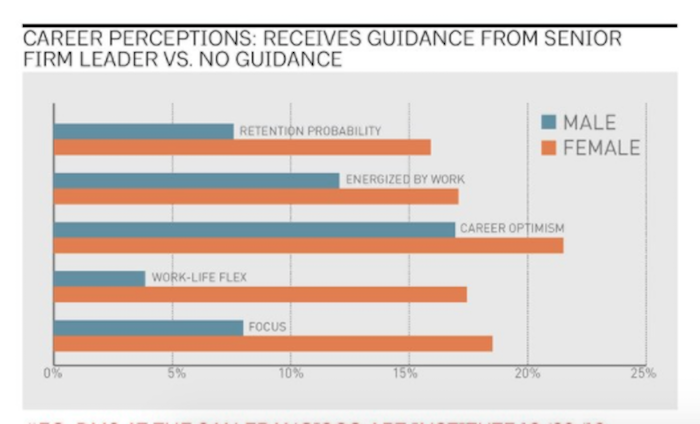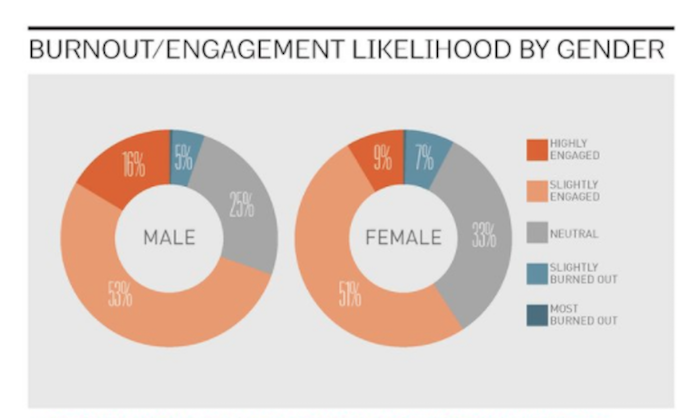A new “Equity in Architecture” survey finds that women and people of color continue to lag white men at architecture firms in career success measures such are salaries and advancement. This “achievement gap,” according to this survey, is less the result of systemic racism or sexism (although both still play in the background, like elevator music, at many firms), and more due to the lack of transparency in a firm’s process of promotions, equal access to its senior leaders, ongoing performance feedback, and having meaningful relationships at work.
The survey, conducted by the Equity by Design committee of AIA San Francisco, is based on responses to more than 80 questions from 8,664 graduates of architecture schools who are either working for an architecture firm, have worked for a firm but currently are employed in another profession, or have worked for a firm but are taking a career break or leave of absence.
The vast majority of respondents, nearly 7,000, are white males or females. And 6,600 respondents currently work at an architecture firm.
Nearly 80% of respondents said they shared their companies’ values, and 60% are engaged in decision-making and “find my work meaningful.” However, a deeper dive into the responses finds that in virtually every metric of success—including autonomy, compensation, confidence, meaningful work, focus, and work-life balance—men are more positive about their situations than women are.

The survey finds that female architects who are encouraged by a firm's senior leaders are more likely to stay with that job, and feel better about it, than men archtects. Image: Atelier Cho Thompson, courtesy of AIA San Francisco Equity in Design Committee.
One reasons might be that men are better prepared than women to take on new roles, based on their perceived respective access to a firm’s partner, principal or direct manager for professional guidance. Mentoring is critical to retention, and when women receive guidance from one of their firm’s senior leaders, they are more likely than men to stay at their jobs, be energized by their work, and be optimistic about their careers. Career guidance also has a positive effect on women architects’ attitudes about work-life balance and “focus.”
One-fifth of the survey’s respondents said that the top reason why they left their last job was low pay. And the survey finds ongoing disparities in the salaries being paid men versus women. For example, the average salary for male respondents with eight to 10 years’ experience was around $75,000, versus around $70,000 for women with the same tenure. The salary gap between men and women widens with experience. And a woman architect who is a parent, regardless of experience, is likely to be paid less than childless women, or men with or without children.
Annelise Pitts, a designer with Bohlin Cywinski Jackson and research chairman of Equity by Design, notes that women—who account for two-fifths of architecture school graduates—early in their careers often get shuttled into less-than-edifying tasks like office manager or office librarian. This “gender sorting,” says Pitts, gives women less of a shot at eventually being included in the firm’s strategic management decisions.
Once an architect has been with a firm for more than a decade, there is a significant jump in his or her perception about the likelihood of becoming a principal in their firm. However, more than half of all respondents said their firms’ leadership is “mostly male.” And 27% of male respondents and 32% of female respondents said their companies’ promotion process is either somewhat or very ineffective. Non-white males are the least likely employees to be made principals, the survey showed.
(While the survey only touches on workplace diversity, Pitts says that the biggest issue for the architectural industry remains “getting people of color into the pipeline in the first place.” Research also finds that even when minority employees are hired, they are more likely to leave firms sooner than white men or women.)
More than three-fifths of the respondents said they have “scheduling conflicts” that present challenges to maintaining a work-life balance. And women more than men attribute poor health, neglected duties, and relationship conflicts in their personal lived to this imbalance. “Women seem more willing to compromise their personal lives for work,” says Pitts. However, women are also more likely than men to turn down work-related travel because of conflicts with their personal lives.
 Women architects are more likely than men to sacrifice their personal lives for work, but are also more likely to feel the pressures of the job. Image: Atelier Cho Thompson, courtesy AIA San Francisco Equity in Design committee.
Women architects are more likely than men to sacrifice their personal lives for work, but are also more likely to feel the pressures of the job. Image: Atelier Cho Thompson, courtesy AIA San Francisco Equity in Design committee.
Burnout is more prevalent among women, especially those with less than five years experience. Half of the female respondents with five or fewer years on the job left their firm, compared to 42% of men with that same tenure who exited. Interestingly, more-tenured women appear to be less likely to leave their firms than experienced men.
Among the respondents, 667 men and 719 women currently work outside of an architecture practice. The vast majority works in another field, with a relatively small number—less than 10%—either being a full-time caregiver, a student, unemployed, or retired.
The solution to hiring and retention problems at architecture firms the survey exposes, says Pitts, comes down to them having policies in place that emphasize progressive and fair employee development, and enforcing those policies equitably and transparently. “Companies need to walk the walk,” she says.
Related Stories
K-12 Schools | Apr 11, 2024
Eric Dinges named CEO of PBK
Eric Dinges named CEO of PBK Architects, Houston.
Construction Costs | Apr 11, 2024
Construction materials prices increase 0.4% in March 2024
Construction input prices increased 0.4% in March compared to the previous month, according to an Associated Builders and Contractors analysis of the U.S. Bureau of Labor Statistics’ Producer Price Index data released today. Nonresidential construction input prices also increased 0.4% for the month.
Healthcare Facilities | Apr 11, 2024
The just cause in behavioral health design: Make it right
NAC Architecture shares strategies for approaching behavioral health design collaboratively and thoughtfully, rather than simply applying a set of blanket rules.
K-12 Schools | Apr 10, 2024
A San Antonio school will provide early childhood education to a traditionally under-resourced region
In San Antonio, Pre-K 4 SA, which provides preschool for 3- and 4-year-olds, and HOLT Group, which owns industrial and other companies, recently broke ground on an early childhood education: the South Education Center.
University Buildings | Apr 10, 2024
Columbia University to begin construction on New York City’s first all-electric academic research building
Columbia University will soon begin construction on New York City’s first all-electric academic research building. Designed by Kohn Pedersen Fox (KPF), the 80,700-sf building for the university’s Vagelos College of Physicians and Surgeons will provide eight floors of biomedical research and lab facilities as well as symposium and community engagement spaces.
K-12 Schools | Apr 10, 2024
Surprise, surprise: Students excel in modernized K-12 school buildings
Too many of the nation’s school districts are having to make it work with less-than-ideal educational facilities. But at what cost to student performance and staff satisfaction?
Industrial Facilities | Apr 9, 2024
Confessions of a cold storage architect
Designing energy-efficient cold storage facilities that keep food safe and look beautiful takes special knowledge.
Cultural Facilities | Apr 8, 2024
Multipurpose sports facility will be first completed building at Obama Presidential Center
When it opens in late 2025, the Home Court will be the first completed space on the Obama Presidential Center campus in Chicago. Located on the southwest corner of the 19.3-acre Obama Presidential Center in Jackson Park, the Home Court will be the largest gathering space on the campus. Renderings recently have been released of the 45,000-sf multipurpose sports facility and events space designed by Moody Nolan.
Green | Apr 8, 2024
LEED v5 released for public comment
The U.S. Green Building Council (USGBC) has opened the first public comment period for the first draft of LEED v5. The new version of the LEED green building rating system will drive deep decarbonization, quality of life improvements, and ecological conservation and restoration, USGBC says.
Codes and Standards | Apr 8, 2024
Boston’s plans to hold back rising seawater stall amid real estate slowdown
Boston has placed significant aspects of its plan to protect the city from rising sea levels on the actions of private developers. Amid a post-Covid commercial development slump, though, efforts to build protective infrastructure have stalled.

















